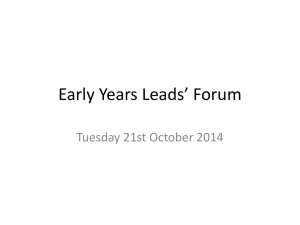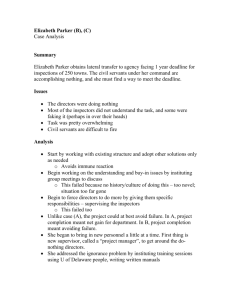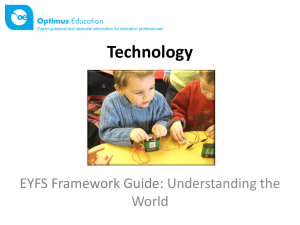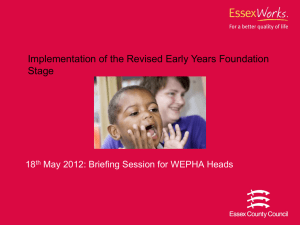Supporting Measure for the Good Level of Development
advertisement
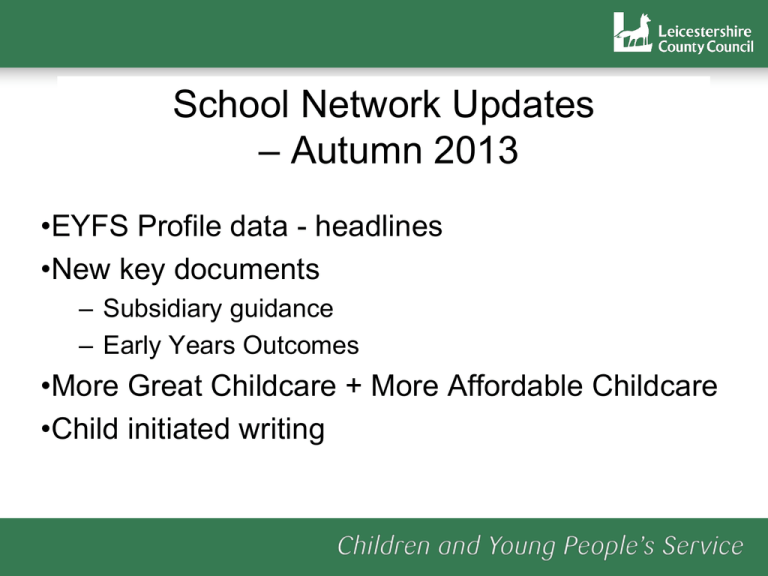
School Network Updates – Autumn 2013 •EYFS Profile data - headlines •New key documents – Subsidiary guidance – Early Years Outcomes •More Great Childcare + More Affordable Childcare •Child initiated writing EYFS Profile - Headlines Good Level of Development (GLD) At least expected in all of the early learning goals in: • prime areas of learning plus • specific areas of literacy and mathematics Supporting Measure for the Good Level of Development This takes performance across all 17 ELGs. 1 - emerging ; 2 – expected; 3 - exceeding. Score between 17 and 51. All children’s scores are totalled and then averaged to calculate the figure EYFS Profile - Headlines Good Level of Development (GLD) 46.4% of Leicestershire children achieved a good level of development 52% - nationally Supporting Measure for the Good Level of Development The supporting measure for Leicestershire is 32.4 32.8 – nationally (the average score) EYFS Profile - Headlines Good Level of Development • girls - 53.9% (60% - nationally) • boys - 39.5% (44% - nationally) • Autumn born - 58.4% • Summer born - 36.2% • Summer born boys - 29.4% • Children in receipt of Pupil Premium - 25.7% EYFS Profile - Headlines Individual ELGs and percentage of children achieving at least expected: Highest % Health and self care Technology Moving and Handling 90.2% 87.7% 85.9% Lowest % Writing Numbers Reading 58.0% 65.5% 69.3% EYFS Profile - Headlines Need to continue to develop: • Quality assurance • Internal moderation • Data analysis Updated EYFSP STA • 2014 handbook reflects current government advice and policy (all references to ‘Development Matters’ removed) • Consistency between EYFS profile handbook and ARA • Explanatory notes removed • 2nd page added to each ELG • Updates – e.g. p.52 – using what they know in their play – lines of enquiry updated • Additions – characteristics of learning added to blank exemplar Updated EYFSP STA Considering further guidance on: • Children on threshold between attainment bands • SEN, EAL, children with speech and language issues • “exceeding” and “emerging” bands of attainment • Reading, writing and number • STA have action plan in place – awaiting outcome of consultation on assessment New key documents • Subsidiary guidance - September 2013 • Early Years Outcomes - September 2013 Subsidiary Guidance – Sept 2013 17.There are no national data for attainment on entry to nursery and reception and no prescribed methods of assessing children when they start school. The age bands describe the ‘typical development’ for children at that age but schools do not have to use these and may have other ways of assessing children when they start school. Inspectors should not use the terms ‘average’ and ‘standards’ as there is no ‘national average’ and there are no standardised expectations for three- and four-year-olds on entry to nursery and reception. Inspectors should discuss with the school’s leaders how they measure children’s starting points and the proportions of children that demonstrate development that is typical for their age. Subsidiary Guidance – Sept 2013 18. Schools should have clear systems to: • make an assessment of children’s starting points (baseline) • plan next steps that challenge children sufficiently • track the progress of individuals, groups of children and cohorts across the Early Years Foundation Stage and into Key Stage 1 • identify how much progress is made by individuals as well as groups of children and the cohort. Subsidiary Guidance – Sept 2013 20. Individual children may be: • operating at a level below that typical for their age but not significantly so (this may reflect a lack of pre-school experience) • showing a typical level of development for their age • operating at a level above that typical for their age (indicating the potential to exceed the early learning goals by the end of reception). Subsidiary Guidance – Sept 2013 22. Inspectors should use their professional judgement when evaluating the starting point of a cohort of children. If a substantial number of new children start school in reception or leave after nursery (age four), inspectors should evaluate attainment on entry to reception as well as to the nursery. Inspectors should also take into account children who start reception part-way through the year. They should check arrangements for ‘staggered entry’ and part- and full-time attendance, as the amount of time spent in school may affect both attainment and progress. Subsidiary Guidance – Sept 2013 25. The national data from DfE will not be available until November 2013. Inspectors should use the school’s data until the national data are available. Data from previous years will reflect the previous system of assessment and inspectors should not try to make any comparisons between the results from the old and new system. 16. The DfE has placed on its website a new document called ‘Early Years Outcomes’ as a non-statutory aide to support practitioners. Early Years Outcomes – Sept 2013 A non-statutory guide for practitioners and inspectors to help inform understanding of child development through the early years This document is a non-statutory guide to support practitioners. It can be used by childminders, nurseries and others, such as Ofsted, throughout the early years as a guide to making best-fit judgements about whether a child is showing typical development for their age, may be at risk of delay or is ahead for their age. • Discussion time More Great Childcare – More Affordable Childcare • Govt agenda - shift in power to communities and away from LA • Further LCC cuts • Will work with only 25% of providers - requires improvement and inadequate. • Emphasis on vulnerable children and families. • Service being restructured - new service by April 2014. Hope to maintain school network update meetings.

